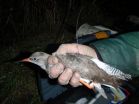(Press-News.org) CHICAGO – Although current guidelines recommend 3 months of anticoagulation treatment after bioprosthetic aortic valve replacement surgery, a study that included more than 4,000 patients found that patients who had warfarin therapy continued between 3 and 6 months after surgery had a lower rate of cardiovascular death, according to a study in the November 28 issue of JAMA.
"Biological prostheses are preferred to mechanical valves for aortic valve replacement (AVR) surgery in elderly patients older than 65 years because of shorter life expectancy and lack of a need to use anticoagulation treatment in the long-term. Especially in these patients, the tradeoff between thromboembolic complications due to the valve implant and bleeding events as adverse effects from anticoagulation therapy must be balanced. Nevertheless, appropriate duration of anticoagulation treatment postoperatively is yet to be established because the risk of complications when the treatment is discontinued is unknown," according to background information in the article. The current recommendation of 3 months of warfarin treatment after bioprosthetic AVR surgery is primarily based on results from 1 retrospective study with a limited number of events.
Charlotte Merie, M.D., of the Copenhagen University Hospital Gentofte, Copenhagen, Denmark and colleagues investigated whether discontinuation of warfarin treatment within prespecified periods after bioprosthetic AVR surgery was associated with increased risk of thromboembolic complications, cardiovascular death, and bleeding incidents. Through a search in the Danish National Patient Registry, 4,075 patients were identified who had bioprosthetic AVR surgery performed between January 1997 and December 2009. The researchers determined the incidence rate ratios (IRRs) of strokes, thromboembolic events, cardiovascular deaths, and bleeding incidents by discontinuing warfarin as opposed to continued treatment at 30 to 89 days, 90 to 179 days, 180 to 364 days, 365 to 729 days, and at least 730 days after surgery. Average age of the patients was 75 years; 41 percent were women.
Overall, 361 patients (8.9 percent) experienced a stroke, 615 (15.1 percent) had a thromboembolic event, and 364 (8.9 percent) encountered a bleeding incident after the date of surgery. During the observation period, 1,156 patients (28.4 percent) died, with 879 (76.0 percent) of these deaths related to cardiovascular disease. The IRRs for patients not treated with warfarin compared with those treated with warfarin were 2.46 for stroke; 2.93 for thromboembolic events; 2.32 for bleeding incidents; and 7.61for cardiovascular deaths within 30 to 89 days after surgery; and 3.51 for cardiovascular deaths within 90 to 179 days after surgery.
"Our study demonstrates that discontinuing warfarin therapy within the first 3 months after surgery is associated with a significant increase in the risk of stroke, thromboembolic complications, and cardiovascular death. The novelty of our study is the finding that discontinuing warfarin therapy within 90 to 179 days after surgery is associated with a significant increase in the risk of cardiovascular death," the authors write.
"International guidelines on anticoagulation after a bioprosthetic AVR have been written with limited data on the appropriate duration of warfarin treatment after surgery. Consequently, our study challenges current guidelines on the duration of antithrombotic treatment after AVR surgery with biological valves by presenting results suggesting that these patients will gain from an additional 3 months of warfarin treatment in terms of reduced cardiovascular death without risking a significant increase in bleeding events."
(JAMA. 2012;308(20):2097-2107; Available pre-embargo to the media at http://media.jamanetwork.com)
Editor's Note: This work was supported by the Research Fund of the Department of Cardiology at Copenhagen University Hospital Gentofte, Gentofte, Denmark. Please see the article for additional information, including other authors, author contributions and affiliations, financial disclosures, etc.
Editorial: Warfarin After Bioprosthetic Aortic Valve Implantation
Shamir R. Mehta, M.D., M.Sc., and Jeffrey I. Weitz, M.D., of McMaster University and Hamilton Health Sciences, Hamilton, Ontario, Canada, comment on the findings of this study in an accompanying editorial.
"Will the results of this study change practice in patients undergoing bioprosthetic aortic valve replacement? Should all of these patients receive warfarin for 3 months, or even for 6 months, as the authors suggest? Although there are limitations to this study, the answer to both of these questions is yes. This study shows that the rates of stroke and thromboembolic events in the first 6 months after bioprosthetic aortic valve replacement are substantial among patients not treated with warfarin. Use of warfarin was associated with a reduction in this risk and a reduction in cardiovascular mortality; these benefits are difficult to ignore."
(JAMA. 2012;308(20):2147-2148; Available pre-embargo to the media at http://media.jamanetwork.com)
Editor's Note: The authors have completed and submitted the ICMJE Form for Disclosure of Potential Conflicts of Interest. Dr. Mehta reported serving as a consultant for AstraZeneca, Eli Lilly, and Sanofi. Dr. Weitz reported serving as a consultant for Boehringer Ingelheim, Bayer, Pfizer, and Bristol-Myers Squibb.
###
To contact Charlotte Merie, M.D., email c.merie@mail.dk. To contact editorial co-author Shamir R. Mehta, M.D., M.Sc., call Veronica McGuire at 905-525-9140, ext. 22169, or email vmcguir@mcmaster.ca.
END
SALT LAKE CITY, Nov. 27, 2012 – A University of Utah study produced new mathematical support for a theory that explains why men in some cultures often feed and care for their sisters' children: where extramarital sex is common and accepted, a man's genes are more likely to be passed on by their sister's kids than by their wife's kids.
The theory previously was believed valid only if a man was likely to be the biological father of less than one in four of his wife's children – a number that anthropologists found improbably low.
But in the new study, University of ...
Coasts and estuaries are among the most rapidly developing areas on Earth. Night-time satellite images of the planet show that except Antarctica, continents are ringed with halos of brightly-lit human development. But coasts are also key wildlife sites. Every year, millions of waterbirds arrive from the Arctic to overwinter on UK coasts, yet scientists remain largely in the dark about how these birds respond to the bright lights of coastal cities and industry.
To shed light on the issue, Dr Ross Dwyer and colleagues from the University of Exeter investigated how artificial ...
Sea-levels are rising 60 per cent faster than the Intergovernmental Panel on Climate Change's (IPCC) central projections, new research suggests.
While temperature rises appear to be consistent with the projections made in the IPCC's fourth assessment report (AR4), satellite measurements show that sea-levels are actually rising at a rate of 3.2 mm a year compared to the best estimate of 2 mm a year in the report.
The researchers, from the Potsdam Institute for Climate Impact Research, Tempo Analytics and Laboratoire d'Etudes en Géophysique et Océanographie Spatiales, ...
ANN ARBOR, Mich. — About 70 percent of women who have both breasts removed following a breast cancer diagnosis do so despite a very low risk of facing cancer in the healthy breast, new research from the University of Michigan Comprehensive Cancer Center finds.
Recent studies have shown an increase in women with breast cancer choosing this more aggressive surgery, called contralateral prophylactic mastectomy, which raises the question of potential overtreatment among these patients.
The study found that 90 percent of women who had surgery to remove both breasts reported ...
Heart failure affects 3 per cent of the overall population, and exists in two forms: reduced ability to contract the heart and reduced ability to relax the heart. The former affects younger patients, mostly men, and is treatable. The latter, called HFPEF (heart failure with preserved ejection fraction), affects older patients and women, and until now there has not been any treatment available against the disease.
In the present study, a team comprising researchers at Karolinska Institutet, Linköping University, Stockholm South General Hospital and Karolinska University ...
Digoxin, a drug that has been used worldwide for centuries to treat heart disease, is associated with a significant increase in deaths in patients with atrial fibrillation (AF), according to results from a study published online today (Wednesday) in the European Heart Journal [1].
Digoxin is extracted from the foxglove plant (digitalis) and it helps the heart beat more strongly and with a more regular rhythm. It is commonly used in AF patients, and also in patients with heart failure. However, it can be problematic to use successfully as there is a narrow dose range at ...
People with an overactive thyroid gland (hyperthyroidism) carry a greater risk of developing irregular heart rhythm (known as atrial fibrillation) than those with normal thyroid function, finds a study published on bmj.com today.
As such, the researchers suggest there should be an increased focus on atrial fibrillation in patients with raised thyroid function.
Hyperthyroidism occurs when the thyroid gland makes too much thyroxine (thyroid hormone), causing many of the body's functions to speed up. About 1 in 100 women and 1 in 1,000 men develop hyperthyroidism at some ...
Women who develop pre-eclampsia during their first pregnancy (known as preterm pre-eclampsia) - and who don't go on to have any more children – are at greater risk of dying from heart disease in later life than women who have subsequent children, finds a study published on bmj.com today.
Women who develop the condition only in the final weeks of pregnancy (known as term pre-eclampsia) are at less risk.
This high risk to one child mothers has not been previously reported and suggests that these women need special monitoring, especially if their pre-eclampsia was preterm. ...
That sea level is rising faster than expected could mean that the Intergovernmental Panel on Climate Change's (IPCC) sea-level rise projections for the future may be biased low as well, their results suggest.
Sea-level rise potentially affects millions of people all around the world in coastal areas as well as megacities like Tokyo.
"Global temperature continues to rise at the rate that was projected in the last two IPCC Reports. This shows again that global warming has not slowed down or is lagging behind the projections," Rahmstorf says. Five global land and ocean ...
Fresh insight into the parasite that causes malaria suggests a new way to develop drugs and vaccines to tackle the disease.
Research into malaria parasites – which exist in male and female forms, and mate to spread the disease – suggests that treatments would be more likely to succeed if designed to target female forms of the parasite.
Scientists found that male parasites can adapt to new surroundings faster than the females. When malaria infects the bloodstream after a mosquito bite, the male parasites are better able to react quickly to repeated attacks by the immune ...


